13 Lunch Ideas for 1-Year-Olds to Make Lunchtime a Snap
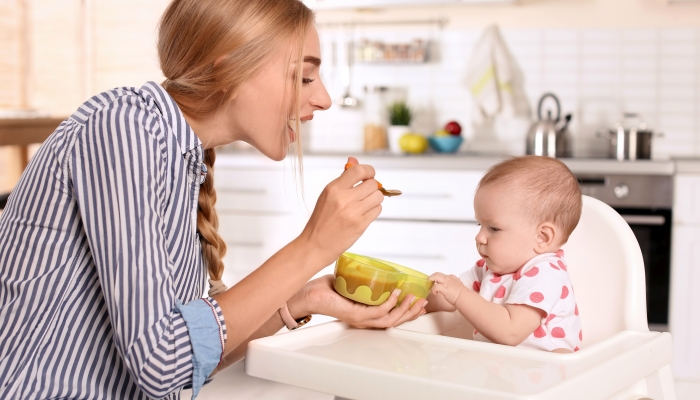
- Aiming to provide a variety of foods from each food group will give your child’s body the building blocks it needs.
- Items like green beans, red grapes, mandarin oranges, or raspberries will add pops of color to your toddler’s plate and a boost of nutrition.
- Creating an animal face with food on your child’s plate can encourage them to taste new foods.
Somedays mealtimes are pure magic in our house. All the kids eat their food without complaining and the meal is nothing but smiles and giggles. Then there are the other days.
On difficult days, we usually have at least one child protesting their vegetables while another child seems to have forgotten how to sit in their seat. It’s on these days that I wish I could snap my fingers and make mealtime magically come back together.
Eleven years into motherhood, and I still haven’t figured out how to avoid every mealtime mishap. But I have mastered a few tricks that work wonders with toddlers, especially at lunchtime. These cute, but determined, little beings often have strong opinions about food.
Through my experience raising my own toddlers, I’ve learned that you can teach them to enjoy healthy foods in fun and simple ways. I’ve also come up with numerous toddler lunch ideas that make lunchtime easy.
Try these 13 lunch ideas for 1-year-olds to make lunchtime a snap in your home.
What Time Should a 1-Year-Old Have Lunch?
If you’ve talked with other parents about their daily schedule, you’ve probably noticed that each family has their own routine. Some toddlers take morning naps, while others only nap in the afternoon. Some families wake up at 6 am, while others sleep in until 8 am.
Your family’s schedule will determine what time your 1-year-old has lunch. If you have an early riser, your 1-year-old might eat lunch around 10:30 or 11 am. If you have a late riser, they might not eat until 12 or 1 pm.
Here are a few guidelines to help you determine the right time for your 1-year-old to eat lunch:
- Plan on feeding your toddler every 2 to 3 hours to avoid a hunger meltdown.
- Determine a good time for lunch by looking at your daily schedule. Feeding your child lunch before their afternoon nap is usually helpful.
- If the time between waking and when you plan to serve lunch is more than 3 hours, plan to give your toddler a snack in between.
What Time Is It Too Late To Give Your Baby Lunch?
All mealtimes are important, as they provide the bulk of calories and nutrients for your child. You don’t want your child just going through the day snacking and missing out on protein, vegetables, whole grains, dairy, or any other food groups.
Aim to give your child lunch sometime about halfway between breakfast and dinner. This doesn’t need to be exact, but there should be a few hours between lunch and dinner. This will allow them time to properly digest their food and be hungry enough for the next meal.
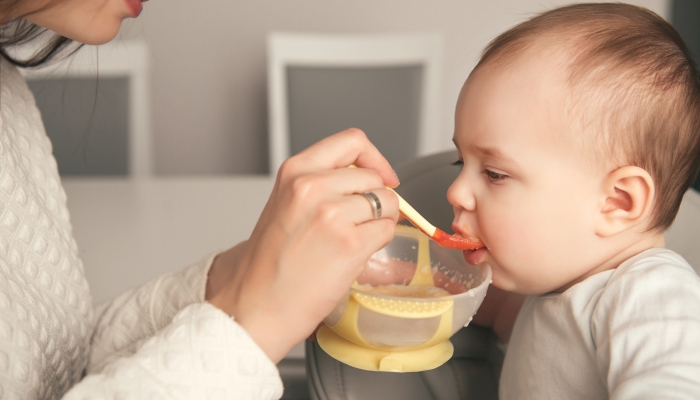
What Should You Give Your 1-Year-Old for Lunch?
When you shop for foods for your 1-year-old, you’ll want to keep their nutritional needs in mind.
A 2018 statement from the American Academy of Pediatrics by Sarah Jane Schwarzenberg, MD, Michael K. Georgieff, MD, and the Committee on Nutrition, titled Advocacy for Improving Nutrition in the First 1000 Days to Support Childhood Development and Adult Health, stressed that the nutrition a child gets in the womb and the first two years of life are “crucial factors in a child’s neurodevelopment and lifelong mental health.”
The foods you give your 1-year-old play a role in ensuring proper development as they hit toddler growth spurts. Though this may seem like a heavy burden, it’s not as difficult as you may think. Providing a variety of foods from each food group will give their body the building blocks it needs.
What Does a Healthy Lunch for Your 1-Year-Old Look Like?
Healthy lunchbox ideas and toddler meal ideas will include several food groups. Let’s take a look at some examples:
Grains
The grains you choose for your 1-year-old should be whole-grain versions. These grains are rich in nutrients and carbohydrates. Your busy little toddler needs carbohydrates for energy.
A few examples of healthy grains include brown rice, whole wheat bread, oatmeal, or buckwheat.
Vegetables
Vegetables provide necessary nutrients like vitamin A and vitamin C. Also, vegetables are full of fiber, which is essential for proper digestion and waste elimination.
It can be difficult to get a picky 1-year-old to eat vegetables. I’ve found that adding them into soups or baked goods, or serving them with dipping options makes it easier to get in a variety of vegetables. Avocados, thinly sliced or cooked carrots, broccoli, sweet potatoes, and peas are great vegetables to try.
Fruit
This might be the easiest food group to include in toddler lunches. Most toddlers will eat at least one or two different types of fruit without complaining. Fruits, in moderation, provide necessary nutrients and antioxidants.
Many 1-year-olds enjoy strawberries, blueberries, watermelon, bananas, and mangoes. Toddlers also enjoy grapes, but be sure to cut each grape into quarters to prevent choking.
Protein
Protein is necessary for proper growth and to build healthy bones, teeth, and muscles. Many of us immediately think of meat when we hear protein. Though meat is high in protein, some 1-year-olds aren’t fond of the texture.
Some meat-alternative proteins include beans, tofu, eggs, nuts or nut butter, and fish. Many of these are sources of healthy fats as well.
Dairy
Dairy is a great source of calcium, vitamin B2, and protein. Toddlers need these nutrients to help build strong bones. There are plenty of easy toddler lunch ideas which add in dairy products such as cheese, milk, and yogurt.
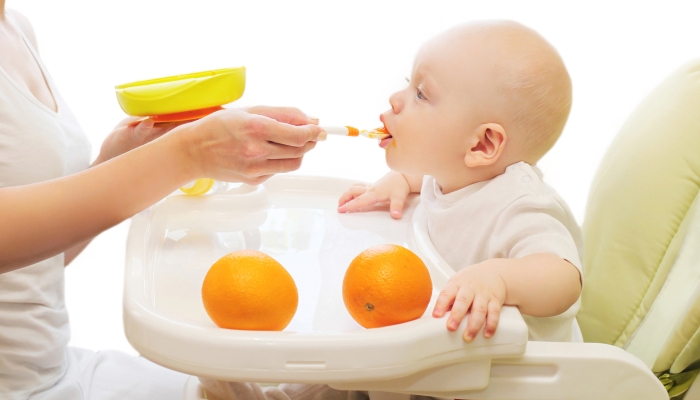
How Much Should a 1-Year-Old Eat for Lunch?
The Committee on Nutrition at the American Academy of Pediatrics has specified recommendations for serving sizes for toddlers. The APA recommends 40 calories per day for every 1 inch in height. If you calculate the calories your child needs per day, you can split them among 3 meals and 2-3 snacks.
The APA further clarifies that this amount is roughly ¼ the size of an adult’s portion for each meal. You can start by adding just a tablespoon of each food group onto your child’s plate or highchair for baby-led weaning.
Tips to Make Lunchtime More Fun for Your 1-Year-Old
Many parents have faced the challenge of keeping their little ones entertained when it’s time to eat. This is probably how the classic “airplane spoon” move was created.
If you find yourself in that same situation, try these tips. Adding a few simple tricks to your lunchtime routine might keep your toddler from flinging their food on the floor.
Music
In our home, music is a huge part of mealtimes. At dinner, we use music to set the atmosphere for family conversations around the table. During lunchtime, I often turn on fun music for the kids to keep them smiling and seated at the table.
Toddlers often love music and mealtimes are the perfect time to use this to your advantage. If your little one seems to get bored easily at lunchtime, add some fun songs. Songs that have animal sounds, hand motions, or silly words might keep their brain engaged while taking bites.
Colorful Plate
Toddlers also love bright colors. Make their plate a little more attractive by adding a variety of colors to it. This is also one of the best ways to ensure they’re getting proper nutrients.
Items like green beans, red grapes, mandarin oranges, or raspberries will add pops of color and a boost of nutrition. Plates look more exciting when they aren’t all one color.
Fun Presentation
One of my favorite tricks for feeding one-year-olds is creating animal faces with their food. I’ll often take a piece of whole wheat bread and top it with something like blueberry eyes, strawberry ears, a raisin nose, and matchstick carrot whiskers. You can find a variety of inspiring animal faces for your toddler’s lunch online.
Creating an animal face with food on your child’s plate, instead of piles of food, will encourage them to taste new foods. Add a dipping sauce like ranch to the plate, and you’re sure to win!
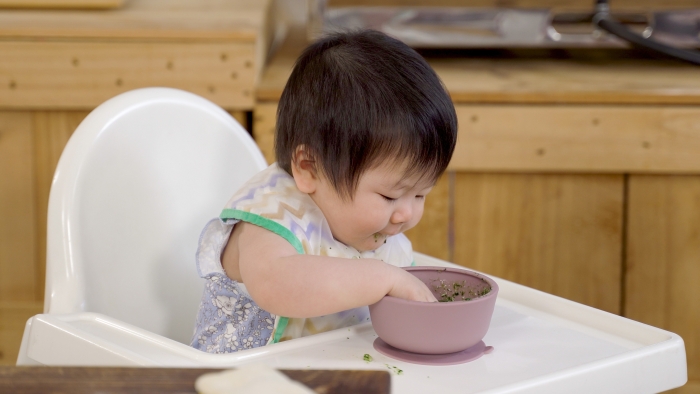
Healthy and Yummy Lunch Ideas for 1-Year-Olds
I’ve probably made thousands of lunches over the past 11 years of motherhood. Truth be told, they haven’t all been wins. However, through trial and error, I’ve come up with several toddler lunch ideas that have pleased even my pickiest eaters.
Here are some healthy toddler lunch ideas that will make mealtime a snap:
Turkey Roll-ups, Cheese, and Strawberries
You can either serve deli turkey slices rolled up in whole wheat tortillas or rolled up plain. Add cheese and strawberries for calcium and antioxidants.
Whole Wheat Grilled Cheese, Broccoli, and Raspberries
This is one of my toddler’s favorite meals. Any type of whole-grain bread will make grilled cheese a healthy, filling option. Add in broccoli for fiber and raspberries for color and antioxidants.
Scrambled Eggs, Yogurt, and Blueberries
This is one of my favorite healthy lunch ideas. Scrambled eggs make a filling lunch full of protein. Add in yogurt for calcium and blueberries for antioxidants and vitamin C.
Roasted Sweet Potato, String Cheese, and Green Beans
We like roasted sweet potatoes coated in olive oil and a dash of cinnamon for a tasty dish. Add whole milk string cheese for calcium and protein and green beans for vitamins and fiber.
Peanut Butter Banana Sandwich with Cucumber sticks
Young toddlers often love the taste of creamy peanut butter and bananas. Serve them on whole grain bread with a side dish of cucumbers to get several food groups in one meal.
Pesto Pasta and Apple Slices
What child doesn’t love pasta and pesto? Apple slices are a sweet treat to pair alongside this whole-grain dish.
Tuna, Whole Wheat Crackers, and Blueberries
Canned tuna makes a fun dip for crackers when you prepare it as tuna salad. Alternatively, you can make chicken salad with cubed chicken or shredded chicken. Add in any fresh fruit to make it a complete meal.
Avocado Toast, Cottage Cheese, and Fresh Fruit
Whole wheat toast is delicious paired with avocado and a dash of olive oil and salt. Add cottage cheese for protein and fresh fruit for something sweet.
Whole Grain Banana Muffins, Greek Yogurt, and Cherry Tomatoes
We like to make mini muffins made with natural sweeteners like bananas for healthy snacks and lunches. Serve them with greek yogurt and cherry tomatoes to add color, nutrients, and protein.
Fish Sticks, Butternut Squash, and Mandarin Oranges
Fish sticks are a great protein source. My kids like roasted butternut squash with a little garlic powder and olive oil. I usually add in a mandarin orange fruit cup for a treat.
Tomato Soup, Cheese Slices, and Whole Wheat Crackers
Pureed tomato soup is an easy way to add hidden veggies. Cheese slices and whole wheat crackers are quick sources of protein and whole grains.
Quesadilla, Roasted Cauliflower, and Black Beans
Serve a quesadilla on a whole wheat tortilla with whole milk shredded cheese for a filling meal. Roasted cauliflower has a delicious buttery flavor. The black beans add extra protein and fiber.
Create Your Own Snack Tray
I’ve found this idea to be an easy lunch when I’m down to limited options in the fridge. Create a “snacking tray” of finger foods by using what you have on hand and placing them on a tray or in a muffin tin. This can include dinner leftovers or bottom-of-the-jar items like pickles and olives.
This also serves as an activity to help your toddler develop their pincer grasp.
FAQs
How should I serve lunch and snacks to my 1-year-old?
I’ve found these tips to be helpful when serving food to toddlers:
- Use plates with dividers to help with food portioning.
- Give your child toddler-size utensils to make eating easier for their little hands.
- Use toddler snack cups when serving snacks. (These prevent spills and messes and are perfect to throw in a daycare bag or diaper bag).
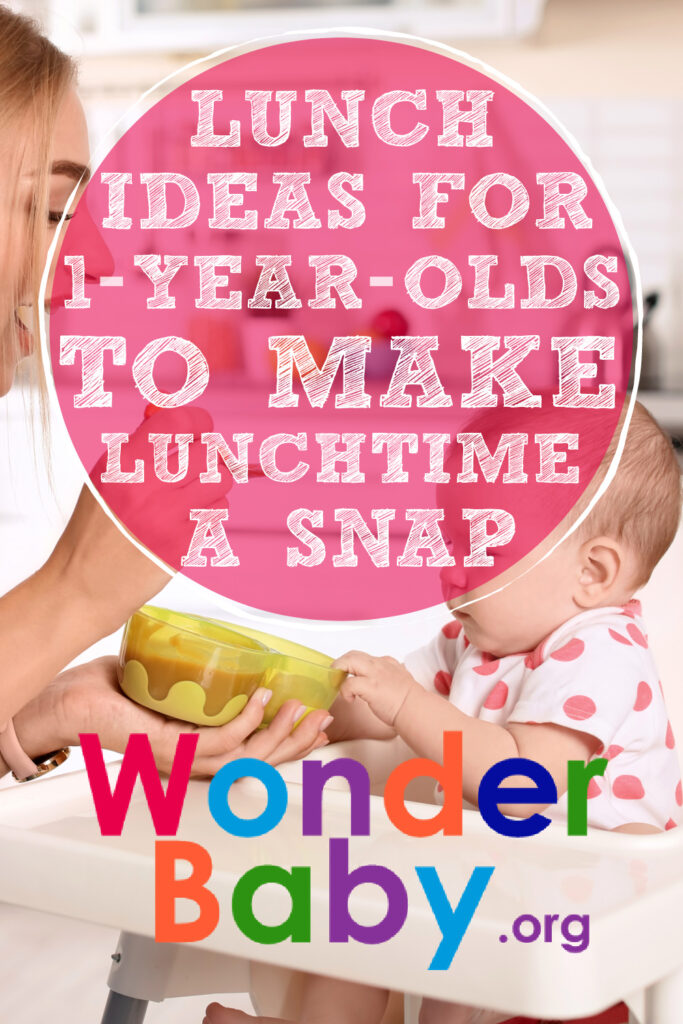
Related Posts
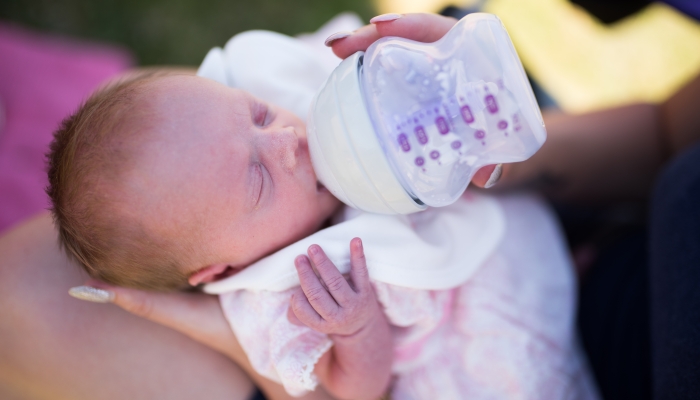
Feeding and Eating, Special Needs
Feeding Therapy Approaches for Infants with Special Needs
Many children with special needs have feeding difficulties. Working with a speech therapist, being patient, and experimenting with textures can help.

Feeding and Eating
Unexpected Foods That Cause Allergen Cross-Reactivity
A variety of unexpected foods and environmental substances can trigger an allergic reaction through cross-reactivity to food proteins.

Feeding and Eating
Easing Anxiety for Families Facing Food Allergies
Ongoing physical preparations and speaking openly about anxiety can ease the transition from diagnosis to living well with a food allergy.